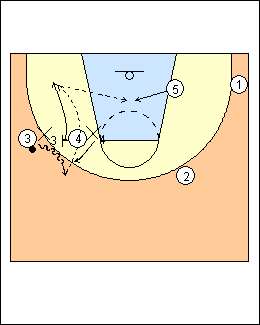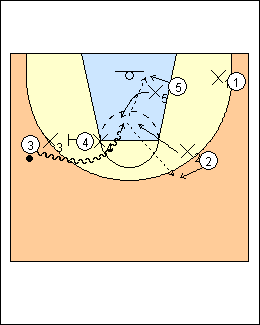Using sidescreens
 | 1 Dave Smart Carleton uses a lot of ballscreens because other teams switch on them. The screener sets the screen with his back to the elbow, inside the 3-point line. The dribbler sells opposite, e.g., with a fake reverse dribble, and reads the xscreener (defender of the screener), Carleton ballscreens the other team's best perimeter scorer to beat him up, and screens with the attacker guarded by the worst ballscreen defender (their big) to get him away from the basket. However, late in the game they use their two best attackers, it's a catch and shoot for the rest. Causes a close-out, usually on the screener. |
 | 2 In general, the screener will screen, open hard, get to the 21 position at about 12 feet [just outside the FIBA lane], and read from there, He will go to the rim and sit and seal on a switch (triangle post), or step out if he can shoot and the defence jams (triangle perimeter), He can get a pass on the roll (first dribble), in the 21 position (second dribble), or stepping out or sealing on the third dribble (more likely stepping out), |
 | 3 Shock X4 shows in 3's path. 3 attacks X4's top foot, stays on it, protects the ball, makes X4 screen X3 (make 2 cover 1), and has a lane to the basket if X4 recovers to 4. 4 spaces based on where he can score from. A pullback dribble is what the defence wants you to do, and you're going to pullback, but do it to attack. Carleton shocks using over-under, Mike MacKay - offensive counters are split any gap (best with a slight hesitation and pullback), back dribble (create space to pass and read), use a relay pass (e.g., to the screener). When xdribbler slides over a ballscreen, he is vulnerable to the dribbler faking to use the screen then driving baseline. Another option is to screen space (an area screen above xdribbler), forcing him to trail or go under. Other options are a hesitation dribble; the screener runs to space if a shooter; or the dribbler attacks the outside shoulder of xscreener, who will often screen xdribbler recovering, Jeff Bauer - against a heavy hedge (or switch), the first option is that the ballhandler should attack the top shoulder of the screen defender, try to get into the paint, and take at least two dribbles away from the screen to create a passing lane to the screener and make it difficult for xscreener to recover. The screener can roll the perimeter defender on his back. The second option is for the screener to slip to the basket, creating an angle for the dribbler to penetrate the middle as xscreener recovers to the screener. If xscreener is good at defending ballscreens, screen for the screener before he comes to screen, then the perimeter player spaces out weakside or rear screens for the post after the ballscreen. |
 | 4 Trap Against a trap, stay on that top foot, keep dragging away, it's the same deal if X4 leaves. Also the screener steps out, and flash a guy into the middle. Mike MacKay - the best counter against a trap is to drag it back as far as possible, creating gaps that can be split, and making recovery more difficult on a pass out of the trap. Hoop Tactics - on a trap, 4 pops to the wing, especially if a shooter, a weakside low post flashes middle, shooters spot up on the weakside forming a 2-1-2 set. Move the ball with sharp passes. On a pass to the post in the middle, the baseline players cut backdoor. Screener 4 also pops if X4 steps out/shows, or can roll to the basket. The weakside low post can flash middle for a pass and hit 4 on the roll. If X3 cheats early over the screen, 3 drives baseline. Jeff Bauer - attack the defence, and look to the other side of the floor. The screener looks to slip to the basket, or to the corner (a safety valve) for a reverse-pivot crack-back pass. Euro ballscreen offence - 3 takes two-three dribbles away, 4 pops to the wing, 5 cuts into the middle near the foul line, and 2 breaks up across from 3 behind ball level (giving the ballhandler three short passing options). |
 | 5 Gap and go under Xscreener is gapping (backing off the screener), dribbler reads that. |
 | 6 After the first screen, the screener readjusts his screen to face the basket. The dribbler pulls back, doesn't pick up his dribble, then attacks opposite where his defender comes from (he can shoot if his defender doesn't come out) If 3 drives baseline, the screener curls behind for a pass if he is a shooter, otherwise he goes to the trailer spot in front of the rim. Set a ballscreen at 15 feet if the dribbler is not a shooter. Mike MacKay - when the screener sees xdribbler go under, an offensive counter is to front pivot and re-screen, the screener can roll to the basket or sprint to space if his defender helps. If xscreener sags off the initial ballscreen, have the screener sprint to space for a shot. Hoop Tactics - 3 can make a quick cross-over or behind-the-back dribble doubling back over 4's screen for a pull-up jumper or drive to the basket. Jeff Bauer - against a team that goes under the ballscreen, have the screener roll the defender on his back, or set a double (side by side) screen, forcing xdribbler over, or use a staggered ballscreen, the first screener should roll xdribbler on his back, a post player should be the last screener to prevent switching. |
 | 7 Jam and squeeze The dribbler reads the jam by xscreener, sells opposite and goes hard to turn the corner. If his defender doesn't get caught up in the double screen, it's a pullback situation in the middle. Once he sees the jam, the screener sets the screen as low as possible. Mike MacKay - offensive counters are a re-screen, hesitation dribble just after the screen, or "hide and seek" - the dribbler stops behind the screen, shows shot with eye fakes, goes hard opposite whichever way xdribbler shows. Set the screen closer to the basket next time. Hoop Tactics - 1 pulls up and takes the open jump shot. |
 | 8 Baseline X3 forces the dribbler to reject the screen, 3 sells middle, attacks baseline. Mike MacKay - a common counter is to re-screen, many teams will also step the screener out for a reversal pass, he passes and follows to ballscreen, his defender must recover quickly to help. Jeff Bauer - if the on-ball defender jumps high side to force baseline, the dribbler can make a quick cross-over move to attack baseline. The screener should set the screen higher than normal. Bill Self - if your defender does not allow you to use the screen, fake at the screen and drive hard opposite, after one dribble baseline try to crossover and drive middle. |
 | 9 Switch It's tough to get something good off the ballscreen, what you get is a mismatch, and a team situation. Carleton is not big on going 1-4, the other team is usually prepared to defend it. The screener rolls hard, sits and seals (does not go to the other side, stays away from help). |
 | 10 The dribbler pulls back to the wing. If smaller than 4, X3 will probably be fronting.Bring a weakside low post high for a pass (usually he would have dived on the ballscreen). He is not looking to swing the ball, he looks for the inside mismatch if X4 is denying 3, or for the close-out mismatch if X4 helps on 4. Put the best shooter in the weakside corner in case his defender helps. Mike MacKay - xdribbler can be easily posted if he goes under the screen to switch, or can be sealed on the roll if he goes over the screen. Keep the dribble alive. Hoop Tactics - 3 looks to feed 4 rolling to the basket or posting up if X3 is smaller (3 will flare allowing 4 to slide down and post up). Or 3 can drive hard, especially when X4 is in foul trouble. If 3 has a definite advantage over X4, screener 4 pops out to the corner allowing a one on one. If X3 and X4 anticipate a switch and zone (don't come together), the screener fakes the screen and slips to the basket. Jeff Bauer - use little-big screens against a switching defence, go to the perimeter mismatch, your team is used to dribble kick. |
 | 11 |
This page was made with Basketball playbook from Jes-Soft
